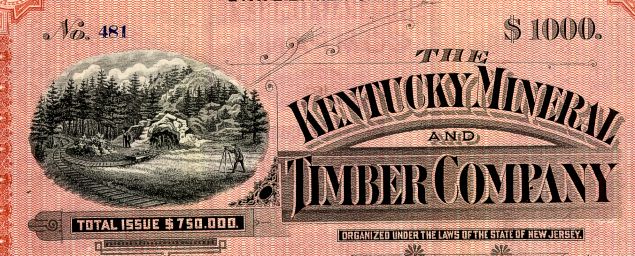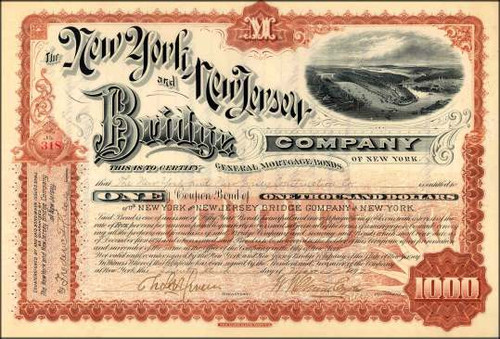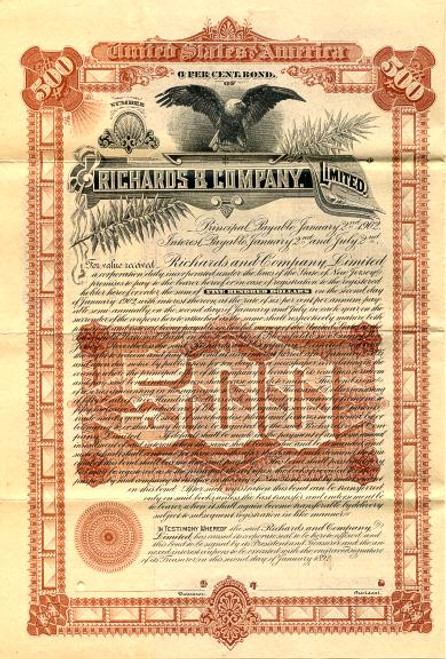Beautiful certificate from the Kentucky Mineral and Timber Company issued in 1892. This historic document was printed by Dennison & Brown Litho Company and has an ornate border around it with a vignette of of surveyors working outside a mine entrance. Red borders and a red background on large white paper. This item has the signatures of the Company's President and Secretary, Thomas F. Ryan and is over 116 years old. Complete coupons to the right side and in excellent condition with bold signatures. Bond is also signed by Brayton Ives as a Trustee on the verso. 
Certificate Vignette Brayton Ives (1840-1914), Union Civil War General, Banker, President of the New York Stock Exchange in 1878 and 1879, and railroad president. During the Civil War, he earned the rank of General through his leadership at Reams's Station, Deep Bottom, Five Forks, and Sayler's Creek. He was also a collector of rare books. Thomas Fortune Ryan (1851 - 1928) was a U.S. tobacco and transport magnate. Part of his fortune paid for the construction of the Cathedral of the Sacred Heart in Richmond, Virginia. Thomas Fortune Ryan was born on 17 October, 1851 near Lovingston, a small Nelson County community south of Charlottesville in Virginia's Piedmont. Despite certain myths regarding his background, Ryan was neither orphaned nor penniless as a youth and he traced his ancestry to Protestant Anglo-Irish settlers in the 1600s, not the Potato Famine Onmigration. Ryan's father was a tailor and manager of a small hotel. Thomas' mother, Lucinda Fortune Ryan, died in 1856 when he was 5. His father remarried and moved to Tennessee two years later, where Ryan was reared by his stepmother's extended family who were Protestants. In 1868, seeking his fortune outside the post-Civil War South, 17-year-old Ryan moved to Baltimore to seek his fortune. En route to Maryland, Ryan converted to Catholicism after long discussions with a fellow passenger on the train. In Baltimore, John S. Barry, a prosperous dry goods merchant, hired him. By 1872, Barry helped Ryan secure a brokerage assistant position on Wall Street. Ryan opened a brokerage firm, Lee, Ryan & Warren, with two partners the following year. In 1873 he married his former boss's daughter, Ida Mary Barry, whose family were devout Catholics. With her he had three children. The first one was the financier and writer John Barry Ryan sr. 1874 - 1942. In 1874, his firm purchased Ryan a seat on the New York Stock Exchange, making him the youngest member in Exchange history. At the same time, Ryan became active in politics, especially the Tammany Hall machine that controlled much of the city's operations, which gave him political and industrial contacts across the city. Ryan's fortune began in public transit. In 1883, he founded the New York Cable Railroad and bid on the proposed route from lower Manhattan to Midtown. After numerous legal and financial problems, in 1886 Ryan re-organized his cable railroad as the Metropolitan Traction Company. By 1893, construction of Ryan's rail system was underway on Broadway. Metropolitan continually acquired additional lines so that by 1900 Ryan controlled most of New York's streetcar operations, totaling 3,000 cars and 300 miles of track. Ryan's most profitable investment was tobacco. Having invested in tobacco stocks throughout the 1890s, Ryan joined his assets in 1898, forming The Union Tobacco Company. Shortly thereafter, Ryan merged his company with that of his greatest competitor, James Duke of North Carolina, forming the American Tobacco Company. Together Ryan and Duke developed the British-American Tobacco Company to protect American tobacco trade in Europe. Upon his death, he also had major holdings in R. J. Reynolds and Liggett & Myers. In 1905, amid public outcry, Ryan purchased the Equitable Life Assurance Society, a major company in the insurance industry with a $400 million in assets. Although Ryan strove to make Equitable more responsive to its policy holders, public reaction to his purchase of the company was overwhelmingly negative. His reputation for cutthroat business dealings in the streetcar and subway businesses made the public distrustful and, in 1909, he sold his Equitable stock. Also in 1905, Ryan's Metropolitan street car system was threatened by a major competitive development, New York's increasingly popular subway system. He merged his company with August Belmont's Interborough Rapid Transit Company. But the joint company's finances were shaky, and Ryan pulled out. Meanwhile, some $35 million that Ryan had raised in a bond issue were misappropriated. Ryan was investigated for corruption in 1908, but the grand jury brought no charges. Meanwhile, Ryan was making fortunes with coal mines, banks, public utilities and railroads. He owned Royal Typewriter and backed the maker of the Tommy gun. At one time Ryan had controlling interest in 30 corporations. As her husband's wealth grew exponentially, Ida Barry Ryan began making large benefactions to Catholic charitable organizations in New York, Virginia, and across the country. The Ryans funded churches, convents and hospitals in Manhattan, including the architecturally important St. Jean-Baptiste on the Upper East Side. In Washington, D.C., they paid for a gymnasium and dormitory at the Jesuit-founded Georgetown University. In 1901, the Ryans funded the construction of Sacred Heart Church and Sacred Heart School on Perry Street in Manchester, Virginia (now part of Richmond). In the same year, the Ryans made their most enduring act of generosity, donating $250,000 to build a new cathedral in Richmond. Soon thereafter, they donated an additional $250,000 to ensure that the interior would be of the highest workmanship. The Cathedral of the Sacred Heart, dedicated in 1906, remains one of the finest architectural landmarks in the city. Other gifts in Virginia included the Cathedral High and the Cathedral Primary schools in Richmond, as well as Catholic churches in Harrisonburg and Newport News. The Ryans' lifetime contributions to Catholic charities around the country totaled $20 million. Ryan was the wealthiest native Southerner when he died in 1928. The Ryans' philanthropy also extended to cultural interests, including Southern history, the fine arts and exploration. Ryan financed and selected Charles Hoffbauer to create "The Four Seasons of the Confederacy", a series of paintings commissioned for a major gallery in what is now the Virginia Historical Society. For Jamestown's 300th anniversary in 1907, Ryan donated a collection of portraits of key players in Virginia's settlement. Ryan also helped finance Richard E. Byrd's flight to the South Pole. By 1912 Ryan announced his intention to retire and was well along in transforming his Oak Ridge property in Virginia into a world-class estate. Ryan re-established his roots in his native state of Virginia. In the same year he was a Virginia delegate to the Democratic National Convention. On October 17, 1917, on his 66th birthday, his wife Ida died from heart disease. Despite a place for her in the crypt of Richmond's Cathedral of the Sacred Heart, she was buried in Hyde Park, New York. Twelve days later Ryan married the widow Mary Townsend Lord Cuyler. On November 23, 1928, Thomas Fortune Ryan died the nation's 10th wealthiest man and the South's wealthiest native son. He was buried at Oak Ridge, where his second wife, Mary, was also interred. He left a fortune of more than $200 million to his descendants. History from Wikipedia and OldCompanyResearch.com (old stock certificate research service).

Certificate Vignette








